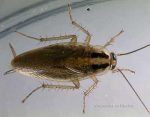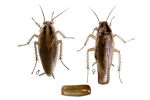Getting Rid of Cockroaches from Your Houston Area Home
What is a German Cockroach?
When you picture a cockroach in your head, it’s most likely a German cockroach that you see. German cockroaches are the most widespread roach variety in the U.S., and are found in all corners of the globe.
German cockroaches are among the most prolific and persistent insects around. One reason for this is their high reproductive rate, with females producing 30 to 40 offspring each reproductive cycle. Another reason is because of they can eat almost anything, from the crumbs of humans’ food to glue and the binding of books. They won’t bite or sting, but are a nuisance, and have been found to be carriers of disease and bacteria. Some people even have allergic reactions to their secretions and shed skin.
Identifying German cockroaches
Fully-grown adults can vary in size from 1/2” to 5/8” long. They have long, narrow bodies, with a small head and two antennae. They have 6 long, thin legs with tiny hair like structures protruding from them. They can be anywhere from a light, nearly translucent tan to light brown, with two very dark brown stripes located right behind their head.
Immature cockroaches, called nymphs, are considerably smaller: about 1/16” to 3/8” long. They look much like their older selves, but are a darker shade of brown.
Where will I find German cockroaches?
German cockroaches, like many insects, are nocturnal. They will do everything in their power to stay away from any light source. This means that, if you see any during the day, it probably means that the hiding places have become overcrowded.
Roaches will spread through your house or apartment along utility lines, laundry vents, trash chutes, and other shared facilities during warm weather. Here is a list of possible hiding places for the German cockroach:
- Light Switches
- Door Frames
- Closets
- Sink Bowls
- Old Newspapers
- Book Cases
- Behind Wallpaper
- Door Hinges
- Ovens
- Behind Paneling
- Brooms
- Above Ceiling Panels
- Behind Pictures
- Garbage Containers
- Light Fixtures
- Paper Bags
- Door chimes
- Mops
- Clocks
- Beverage Cases
- Telephones
- Sinks
- Appliances
- Pleats on Curtains
- Pet Food Bags
- Pipe Holes
- Radiators
- Table Legs
- Medicine Chests
- Computers
- Microwave Ovens
- Basement Rafters
WHAT TO LOOK FOR
- 1/2” to 5/8” long
- Light, translucent tan to brown in color
- Two dark brown stripes right behind the head
- Quickly scurry away from light
- Immature cockroaches, called nymphs, are darker in color and about 1/16” to 3/8” long




